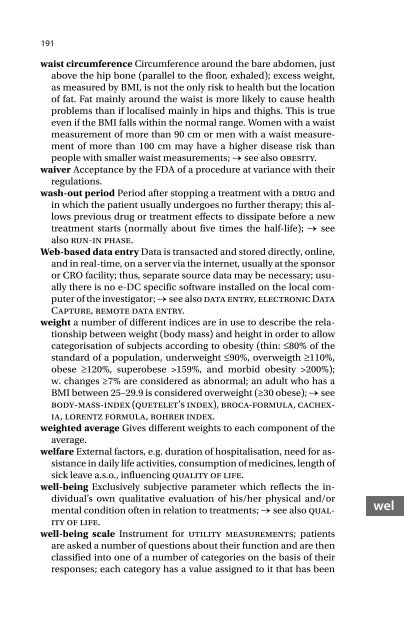220-Dictionary of Pharmaceutical Medicine, 2nd Edition-Gerhard Nahler Annette Mollet-3211898352-S
220-Dictionary of Pharmaceutical Medicine, 2nd Edition-Gerhard Nahler Annette Mollet-3211898352-S
220-Dictionary of Pharmaceutical Medicine, 2nd Edition-Gerhard Nahler Annette Mollet-3211898352-S
You also want an ePaper? Increase the reach of your titles
YUMPU automatically turns print PDFs into web optimized ePapers that Google loves.
191waist circumference Circumference around the bare abdomen, justabove the hip bone (parallel to the floor, exhaled); excess weight,as measured by BMI, is not the only risk to health but the location<strong>of</strong> fat. Fat mainly around the waist is more likely to cause healthproblems than if localised mainly in hips and thighs. This is trueeven if the BMI falls within the normal range. Women with a waistmeasurement <strong>of</strong> more than 90 cm or men with a waist measurement<strong>of</strong> more than 100 cm may have a higher disease risk thanpeople with smaller waist measurements; → see also obesity.waiver Acceptance by the FDA <strong>of</strong> a procedure at variance with theirregulations.wash-out period Period after stopping a treatment with a drug andin which the patient usually undergoes no further therapy; this allowsprevious drug or treatment effects to dissipate before a newtreatment starts (normally about five times the half-life); → seealso run-in phase.Web-based data entry Data is transacted and stored directly, online,and in real-time, on a server via the internet, usually at the sponsoror CRO facility; thus, separate source data may be necessary; usuallythere is no e-DC specific s<strong>of</strong>tware installed on the local computer<strong>of</strong> the investigator; → see also data entry, electronic DataCapture, remote data entry.weight a number <strong>of</strong> different indices are in use to describe the relationshipbetween weight (body mass) and height in order to allowcategorisation <strong>of</strong> subjects according to obesity (thin: ≤80% <strong>of</strong> thestandard <strong>of</strong> a population, underweight ≤90%, overweigth ≥110%,obese ≥120%, superobese >159%, and morbid obesity >200%);w. changes ≥7% are considered as abnormal; an adult who has aBMI between 25–29.9 is considered overweight (≥30 obese); → seebody-mass-index (quetelet’s index), broca-formula, cachexia,lorentz formula, rohrer index.weighted average Gives different weights to each component <strong>of</strong> theaverage.welfare External factors, e.g. duration <strong>of</strong> hospitalisation, need for assistancein daily life activities, consumption <strong>of</strong> medicines, length <strong>of</strong>sick leave a.s.o., influencing quality <strong>of</strong> life.well-being Exclusively subjective parameter which reflects the individual’sown qualitative evaluation <strong>of</strong> his/her physical and/ormental condition <strong>of</strong>ten in relation to treatments; → see also quality<strong>of</strong> life.well-being scale Instrument for utility measurements; patientsare asked a number <strong>of</strong> questions about their function and are thenclassified into one <strong>of</strong> a number <strong>of</strong> categories on the basis <strong>of</strong> theirresponses; each category has a value assigned to it that has beenwel


